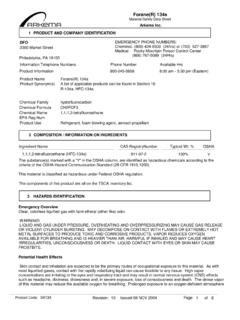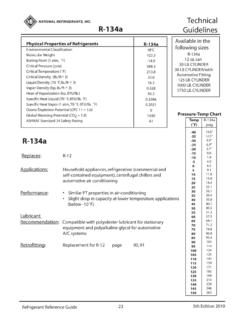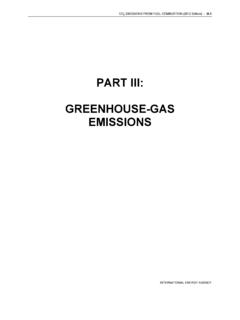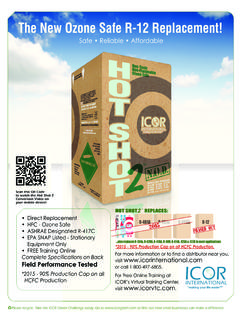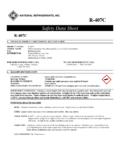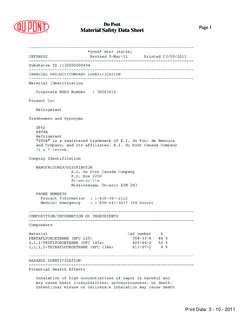Transcription of Federal Clean Air Act Section 609 - ESCO Inst
1 Federal Clean Air Act Section 609 Rev: 09/26//16 Training Manual & Exam Copyright 2016 The ESCO Institute, LTD. All rights reserved No part of this manual may be reproduced, stored in a retrieval system, or transmitted by any means, electronic, mechanical, photocopying, recording, or otherwise, without written permission of the authors. No patent liability is assumed with respect to the use of the information contained herein. While every precaution has been taken in the preparation of this book, the authors and publisher assume no responsibility for errors or omissions. Neither is any liability assumed for damages resulting from the use of the information contained herein. i Who Must Be Training and Test Test Administration and STRATOSPERIC OZONE 1 MONTREAL 1 THE THREE R s Recover - Recycle - 2 REQUIRED 2 3 RECOVERY 4 DISPOSAL OF EMPTY / NEAR EMPTY 4 SHIPPING & 4 RECOVERY 4 5 MANIFOLD GAUGE 5 RECYCLING 5 CHECKING FOR NON-CONDENSABLE 5 LEAK 6 LEAK 6 8 8 RETROFITTING TO 9 OTHER ALTERNATIVES TO 9 TABLE 10 TABLE 11 CERTIFICATION EXAM 12 CERTIFICATION 13 16 ANSWER ENCLOSED Table of Contents 1 REFRIGERANTS FROM NON-MOBILE 3 LOW GLOBAL WARMING POTENTIAL REFRIGERANT 3 4 PROPER CHARGING AND RECHARGING OF MVAC 7 WHO MUST BE CERTIFIED?
2 Any person that services Motor Vehicle Air Conditioning (MVAC) must be certified. Servicing of motor vehicle air conditioning includes repairs, leak testing, and "topping off" of air conditioning systems low on refrigerant, as well as any other repair to the vehicle which requires dismantling any part of the air conditioner. NOTE: Service performed on HCFC 22 air conditioner systems typically found on busses, is NOT covered under Section 609, but rather Section 608 of the Clean Air Act. Technician certification IS required under Section 608. For more information on Section 608 certification, contact The ESCO Institute at 1(800)726 9696. TEST FORMAT The certification test contains 50 multiple choice questions. All of the information necessary for the technician to achieve a passing score on the certification test is contained within this manual.
3 The certification test will contain a variety of questions from each of the topics covered. TRAINING and CERTIFICATION Technician training and certification are not intended to test skills necessary to diagnose problems with, or to repair, motor vehicle air conditioners. Rather, training and certification teach and test technicians on how to properly recover and recycle refrigerant, appropriate handling of refrigerants, the law, and why it must be done to protect the stratospheric ozone layer. TEST ADMINISTRATION & GRADING All tests are electronically graded and records are maintained at the ESCO Institute s Program Development and Grading Center, located in Mount Prospect IL. All inquiries and correspondence should be directed to The ESCO Institute Box 521 Mount Prospect, IL.
4 60056. A technician who successfully completes the exam, by achieving a score of 84% or higher, will receive a certification ID card bearing the technicians name and certificate number. A technician's certification number will be the same as their social security number. Technicians who fail to achieve a passing score will receive a failure notice. Technicians should allow 2 to 3 weeks for the results of their certification exam. Section 609 MOTOR VEHICLE AIR CONDITIONING CERTIFICATION TEST & PREPARATORY MANUAL i STRATOSPHERIC OZONE DEPLETION During the last half century, CFC refrigerants (chlorine fluorine carbon) have drama cally changed our lifestyles. Li le did we know that the use and release of these compounds into the atmosphere would have devasta ng effects on the Earth's environment.
5 The greatest effect is far removed from the Earth's surface, in the Stratosphere. Located between 10 and 30 miles above the Earth's surface, the Stratosphere contains the Ozone layer. The Ozone layer is the earth's security blanket. The Ozone layer serves two important func ons. Ozone protects us from harmful Ultra Violet Radia on and helps to maintain stable Earth temperatures. Deple on of Ozone in the Stratosphere causes; Increased eye disease Skin cancer Crop loss Deforesta on Reduced marine life Increased ground level ozone An Ozone molecule consists of three oxygen atoms (O3). When CFC's are released into the atmosphere, the Ozone molecule is broken down. The Chlorine in the CFC is the culprit. A single Chlorine atom a acks the ozone molecule, taking one of its oxygen atoms, crea ng Chlorine Monoxide (CIO) and Oxygen (O2).
6 The Chlorine Monoxide molecule then goes on to a ack another ozone molecule, taking another oxygen atom, forming more O2 and then releasing the single Chlorine atom. The Chlorine atom con nues this chain reac on destroying as many as 100,000 ozone molecules. It is now clear why the produc on of CFC refrigerants must be phased out and CFC's currently in use must be captured and recycled. Technicians must never inten onally vent refrigerants to the atmosphere. Sec on 609 of the Federal Clean Air Act, as regulated by the US Environmental Protec on Agency (EPA), requires facili es that repair or service motor vehicle air condi oning systems, or dismantle a motor vehicle air condi oner to service other parts of an automobile, must cer fy to the EPA that they are using approved recovery equipment, and that no person may service a motor vehicle air condi oner unless they have been properly trained and cer fied in how to properly recover and recycle refrigerants.
7 The final regula ons for sec on 609 became effec ve as of August 13, 1992. MONTREAL PROTOCOL The Montreal Protocol is an interna onal agreement (treaty) regula ng the produc on and use of CFC's, HCFC s, halons, methyl chloroform, and carbon tetrachloride entered into force in mid 1989. This landmark agreement ini ally called for a produc on and consump on freeze. It currently calls for a stepwise reduc on and eventual produc on phase out of various ozone deple ng substances. The produc on phase out of CFC's was completed on December 31, 1995. At present, HFC 134a is used by most new car manufacturers as a replacement for CFC 12 and older vehicles may be converted to use HFC 134a by following proper retrofit procedures. Although HFC 134a is considered ozone friendly, it is not without environmental impact.
8 It has been found to be a greenhouse gas and contributes to the problems of global warming. Effec ve November 15, 1995, HFC 134a must be recovered. PENALTY Sec on 609 of the Federal Clean Air Act, is regulated by the United States Environmental Agency (EPA). Failure to comply could cost you and your company as much as $27,500 per day, per viola on; and there is a bounty of up to $10,000 to lure your compe tors, customers and fellow workers to turn you in for any viola on. Service technicians who violate the provisions of the Clean Air Act may be fined, lose their cer fica on, and may be required to appear in Federal court. 1 THE THREE "R's" RECOVER - RECYCLE - RECLAIM The processes of recovery, recycling, and reclaiming sound similar, but they are quite different.
9 To RECOVER is to remove refrigerant in any condi on from a system and store it in an approved external container. Recovered refrigerant may not be returned to a motor vehicle air condi oning system (MVAC) without first being recycled or reclaimed. To RECYCLE is to Clean refrigerant for reuse by separa ng the oil and removing moisture by passing it through one or more filter driers. Recycled refrigerant may be returned to a MVAC. Contaminants in recycled refrigerant are limited to moisture, refrigerant oil, and non condensable gases to the levels set by the Society of Automo ve Engineers. To RECLAIM is to process refrigerant to a level equal to new product specifica ons as determined by chemical analysis. RECLAIMED refrigerant must meet standards set forth by the Air Condi oning and Refrigera on Ins tute in ARI standard 700 93.
10 Reclaimed refrigerant is intended for sale and may be used in any applica on. REQUIRED EQUIPMENT The EPA has approved the use of two types of equipment, recover/recycle and recover only. The recover/recycle equipment extracts the refrigerant from the vehicle and cleans the refrigerant on site. The recover only equipment extracts the refrigerant into an approved container to be sent off site for reclama on. Either recover only, or recover/recycle equipment may only be used for the refrigerant for which it was designed. NOTE: UL first cer fied recovery/ recycling equipment in September 1989. Approved equipment must bear a label that states "design cer fied to meet SAE standards". Do not confuse this with other UL labels that indicate equipment safety performance.
